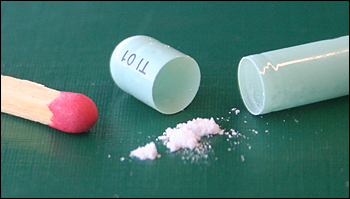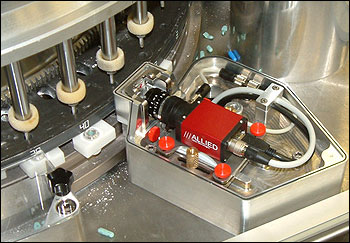
Imaging System Inspects Capsules
The pharmaceutical corporation Boehringer Ingelheim now uses digital cameras from Allied Vision Technologies GmbH for quality assurance in the manufacture of medication capsules.
Few industries are subject to as stringent quality criteria as the pharmaceutical industry because of the potentially serious consequences of error. When it comes to the health of an afflicted human being, no risk is acceptable.

As a result of this fact, in many cases, pharmaceutical production must be inspected to 100 percent accuracy in order to ensure that no defective preparations make their way to patients. How can, for example, 80,000 tiny capsules per hour be reliably tested without interrupting or halting the assembly process? This is a typical case for industrial imaging.
Boehringer was faced with this challenge. At its main location in Ingelheim, the company produces, amongst other items, inhaled medications for respiratory disease. The active ingredient is loaded in micronized powder form into pharmaceutical hard gelatin capsules. Patients then load these capsules into specialized inhalation devices.
Each capsule contains 5.5 mg of powder, which is dispensed by filling machines into the capsules in the form of a weakly compacted cylinder. The precise and yet rapid dosing of such a small amount of powder is a master stroke of Boehringer engineering. Nevertheless, there remains in this procedure, as in any industrial process, a residual risk that the amount deposited into individual capsules might deviate from the intended value.
For Boehringer, such risk was unacceptable. To eliminate it, a highly accurate test system was required, but no capsule filling machinery manufacturer offered such a system. Thus, Boehringer decided to develop and implement an optical testing facility in-house under the direction of senior scientist, Dr. Peter Stöckel.
 The optical system was positioned in the assembly process after the filling and before the sealing of the capsules. After filling, the content of each still-open capsule is imaged from above. The filling machine’s clock pulse triggers a digital camera and its dedicated LED flash unit, not via the computer but rather directly via the camera’s external trigger input. The half-capsule is then illuminated from below using a high-intensity LED. Since the camera cannot be housed over the capsules that are traveling past, it captures their contents via a tilted mirror on the side. The camera in use is a Marlin F-046B from Allied Vision Technologies.
The optical system was positioned in the assembly process after the filling and before the sealing of the capsules. After filling, the content of each still-open capsule is imaged from above. The filling machine’s clock pulse triggers a digital camera and its dedicated LED flash unit, not via the computer but rather directly via the camera’s external trigger input. The half-capsule is then illuminated from below using a high-intensity LED. Since the camera cannot be housed over the capsules that are traveling past, it captures their contents via a tilted mirror on the side. The camera in use is a Marlin F-046B from Allied Vision Technologies.
Via its FireWire connection (IEEE 1394a), the camera transmits the image data to an industrial computer. There, applications software analyzes the images. The software was internally programmed by Boehringer based on NI LabVIEW 7.1 by National Instruments.
After the capsule has been localized within the image, the imaging software first tests whether it contains powder at all. If so, then it analyzes the silhouette of the powder cylinder to derive the volumes and amounts of the active ingredient.
If a capsule is identified as defective, it is sorted out by an SPS-controlled air jet.
The most important challenge for the testing mechanism is speed. “At an output of 80,000 capsules per hour, one capsule leaves the filling machine every 45 ms – put another way, the capsules move at a speed of 1.5 m/s,” calculated Stöckel.
For the camera, this means that 22 capsules per second must be captured. To avoid motion blurring, the exposure time cannot exceed 80 µs. According to Stöckel, the AVT Marlin camera meets these requirements fully and completely.
“We’re very satisfied with the Allied Vision Technologies camera. In continuous operation, it gives us sharp images that are indispensible for reliable evaluation,” he said.
Meanwhile, the imaging system has been installed successfully on several machines in series production.
“We are especially proud to have developed this innovative testing procedure in-house, in cooperation with Allied Vision Technologies and National Instruments,” Stöckel said.
For more information, visit www.alliedvisiontec.com
/Buyers_Guide/Allied_Vision_Technologies_GmbH/c569
Published: September 2010
Glossary
- machine vision
- Machine vision, also known as computer vision or computer sight, refers to the technology that enables machines, typically computers, to interpret and understand visual information from the world, much like the human visual system. It involves the development and application of algorithms and systems that allow machines to acquire, process, analyze, and make decisions based on visual data.
Key aspects of machine vision include:
Image acquisition: Machine vision systems use various...
- optical system
- A group of lenses, or any combination of lenses, mirrors and prisms, so constructed as to refract or reflect light to perform some definite optical function.
AhrensburgAllied Vision Technologiesassembly lineAVTBiophotonicsBoehringercamerascapsulesdigital camerasEuropeGermanyImagingindustrialindustryIngelheimLabViewLight Sourcesmachine visionmanufacturingMarlinmedicinemirrorsmotion blurringNational Instrumentsoptical systemOpticsPeter Stöckelpharmaceuticalsquality controlResearch & TechnologyTest & MeasurementLEDs